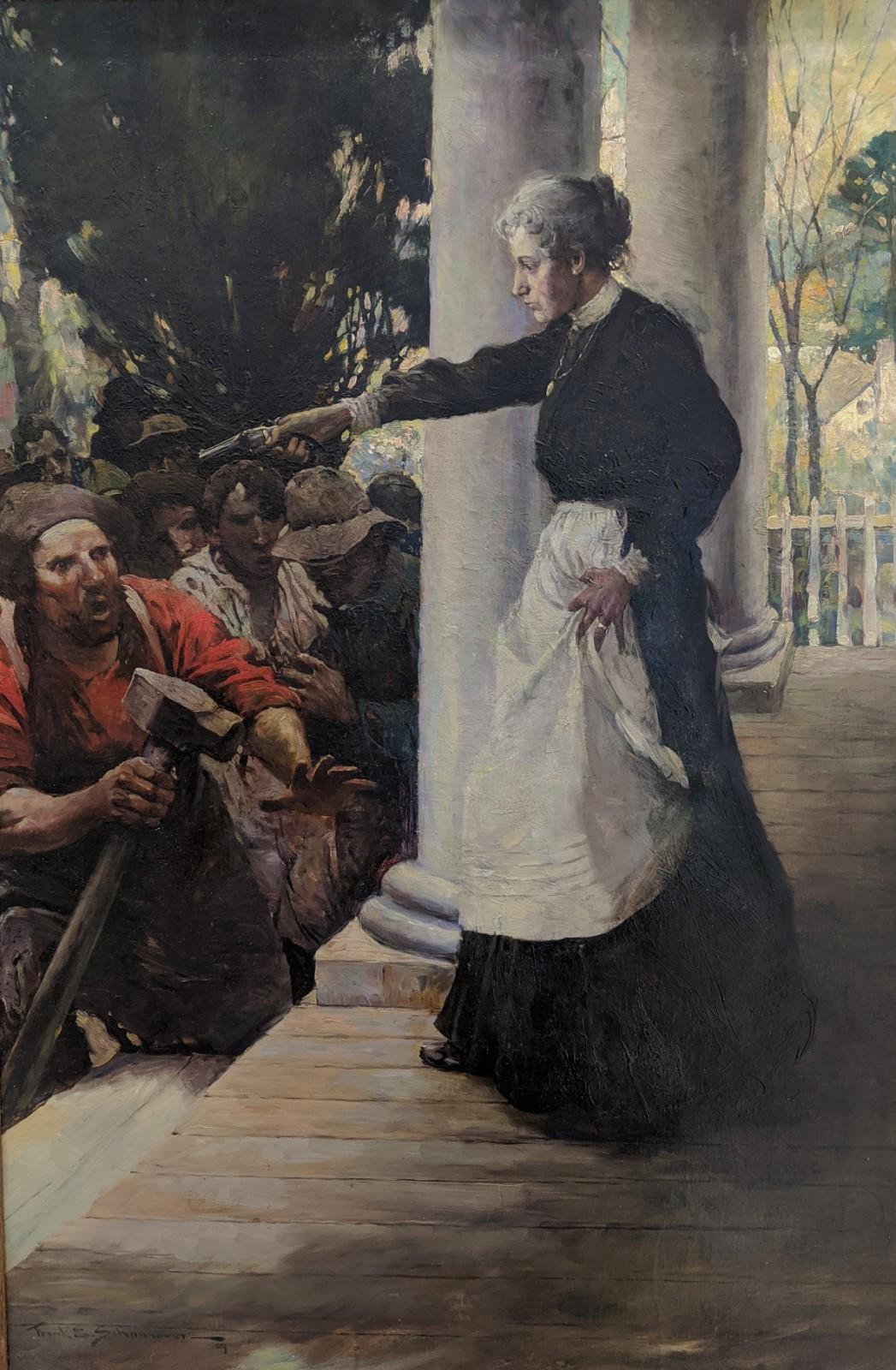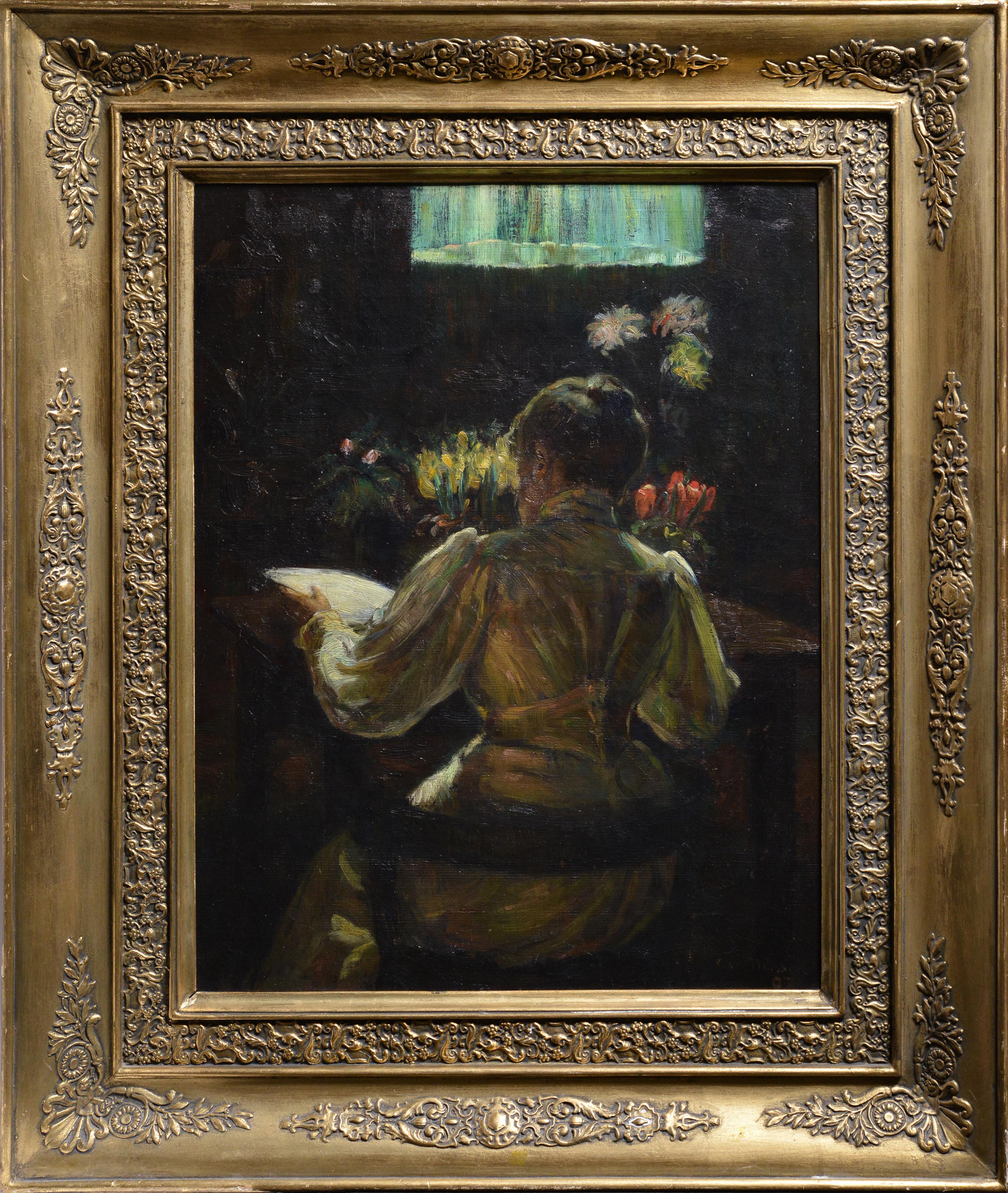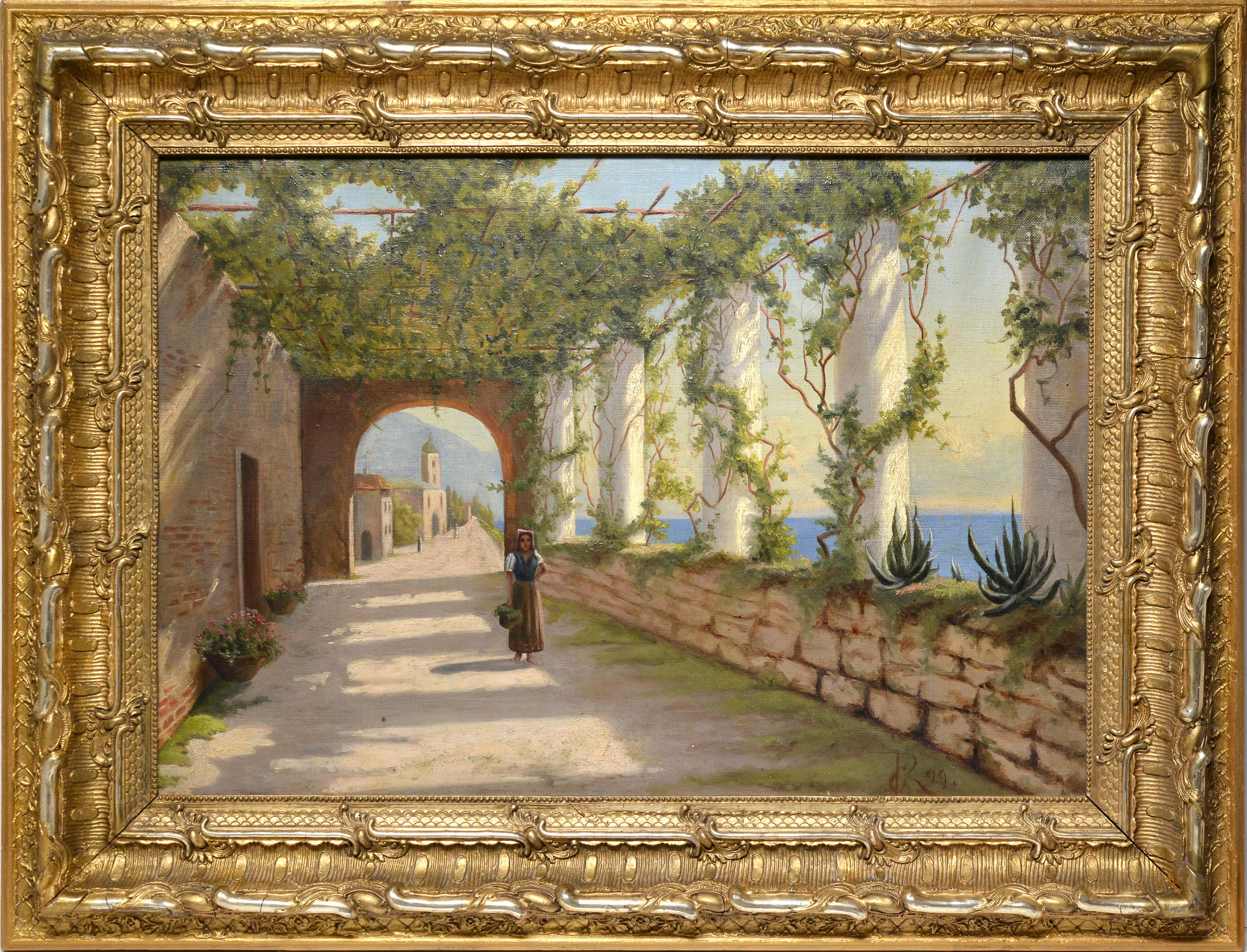Items Similar to "The Concert, " Oil on Canvas Portrait of Monks Playing Instruments
Want more images or videos?
Request additional images or videos from the seller
1 of 10
Thure Cederstrom"The Concert, " Oil on Canvas Portrait of Monks Playing Instruments19th Century
19th Century
About the Item
"The Concert" is an original oil painting on canvas by Thure Cederstrom. It features four men playing music together in a monastery.
Artwork Size: 15" x 20.62"
Frame Size: 22" x 27.5"
Artist Bio:
Thure Nikolaus Cederström, born June 25, 1843 at Åryd's mill, Hemmesjö parish, died May 21, 1924 in Munich, was a Swedish freighter, artist and military.
Thure Cederström was the son of Count Claes Anton Cederström and Catharina Fredrika Aschan and cousin of Gustaf Cederström. He first trained in the military profession and was appointed lieutenant at Livgardet on horseback in 1868.
He applied for leave in 1871 to devote himself entirely to art and began art studies in 1868-1869 through studies for Hugo Salmson in Paris, France. He then studied in Germany in Düsseldorf, Weimar and Munich in 1872–1877. The city of Munich also became his home life. He participated in the Art Academy's exhibitions several times during the 1880s. At an art exhibition in London in 1879 he was awarded a bronze medal. At the international art exhibitions in Munich he was Swedish-Norwegian Commissioner in 1883, Swedish Commissioner in 1888 and a member of the prize jury in 1892. He was appointed agré at the Academy of Fine Arts in Stockholm in 1882 and elected as a member in 1889. His art consists of genre paintings in Eduard von Grützner's style, humorous monastic scenes, interiors and figures. Several of his works ended up in private and public collections in Sweden, and he is represented with Fresh News in the National Museum [ 1 ] Stockholm and Munk reading a jokes in the Gothenburg Art Museum [ 2 ] and Lund University.
- Creator:Thure Cederstrom (1843 - 1924)
- Creation Year:19th Century
- Dimensions:Height: 22 in (55.88 cm)Width: 27.5 in (69.85 cm)
- Medium:
- Movement & Style:
- Period:
- Condition:
- Gallery Location:Milwaukee, WI
- Reference Number:
About the Seller
4.9
Platinum Seller
These expertly vetted sellers are 1stDibs' most experienced sellers and are rated highest by our customers.
Established in 1966
1stDibs seller since 2017
391 sales on 1stDibs
Typical response time: 1 hour
- ShippingRetrieving quote...Ships From: Milwaukee, WI
- Return PolicyA return for this item may be initiated within 14 days of delivery.
More From This SellerView All
- Nude Oil Female Figures Women Realism Expressionism Contemporary Sensual SignedBy Alicia CzechowskiLocated in Milwaukee, WI"The Sauna" is an original oil painting on canvas signed by the artist Alicia Czechowski. It depicts six nude female figures lounging in a sauna. These figures have a wide variety of...Category
1980s Realist Nude Paintings
MaterialsOil
- 'Sketching Wisconsin' original oil painting, SignedBy John Steuart CurryLocated in Milwaukee, WIJohn Steuart Curry "Sketching Wisconsin," 1946 oil on canvas 31.13 x 28 inches, canvas 39.75 x 36.75 x 2.5 inches, frame Signed and dated lower right Overall excellent condition Presented in a 24-karat gold leaf hand-carved wood frame John Steuart Curry (1897-1946) was an American regionalist painter active during the Great Depression and into World War II. He was born in Kansas on his family’s farm but went on to study art in Chicago, Paris and New York as young man. In Paris, he was exposed to the work of masters such as Peter Paul Rubens, Eugène Delacroix and Jacques-Louis David. As he matured, his work showed the influence of these masters, especially in his compositional decisions. Like the two other Midwestern regionalist artists that are most often grouped with him, Grant Wood (American, 1891-1942) and Thomas Hart Benton (American, 1889-1975), Curry was interested in representational works containing distinctly American subject matter. This was contrary to the popular art at the time, which was moving closer and closer to abstraction and individual expression. Sketching Wisconsin is an oil painting completed in 1946, the last year of John Steuart Curry’s life, during which time he was the artist-in-residence at the University of Wisconsin in Madison. The painting is significant in Curry’s body of work both as a very revealing self-portrait, and as a landscape that clearly and sensitively depicts the scenery of southern Wisconsin near Madison. It is also a portrait of the artist’s second wife, Kathleen Gould Curry, and is unique in that it contains a ‘picture within a picture,’ a compositional element that many early painting masters used to draw the eye of the viewer. This particular artwork adds a new twist to this theme: Curry’s wife is creating essentially the same painting the viewer is looking at when viewing Sketching Wisconsin. The triangular composition of the figures in the foreground immediately brings focus to a younger Curry, whose head penetrates the horizon line and whose gaze looks out towards the viewer. The eye then moves down to Mrs. Curry, who, seated on a folding stool and with her hand raised to paint the canvas on the easel before her, anchors the triangular composition. The shape is repeated in the legs of the stool and the easel. Behind the two figures, stripes of furrowed fields fall away gently down the hillside to a farmstead and small lake below. Beyond the lake, patches of field and forest rise and fall into the distance, and eventually give way to blue hills. Here, Curry has subverted the traditional artist’s self-portrait by portraying himself as a farmer first and an artist second. He rejects what he sees as an elitist art world of the East Coast and Europe. In this self-portrait he depicts himself without any pretense or the instruments of his profession and with a red tractor standing in the field behind him as if he was taking a break from the field work. Here, Curry’s wife symbolizes John Steuart Curry’s identity as an artist. Compared with a self-portrait of the artist completed a decade earlier, this work shows a marked departure from how the artist previously presented and viewed himself. In the earlier portrait, Curry depicted himself in the studio with brushes in hand, and with some of his more recognizable and successful canvases behind him. But in Sketching Wisconsin, Curry has taken himself out of the studio and into the field, indicating a shift in the artist’s self-conception. Sketching Wisconsin’s rural subject also expresses Curry’s populist ideals, that art could be relevant to anyone. This followed the broad educational objectives of UW’s artist-in-residence program. Curry was appointed to his position at the University of Wisconsin in 1937 and was the first person to hold any such position in the country, the purpose of which was to serve as an educational resource to the people of the state. He embraced his role at the University with zeal and not only opened the doors of his campus studio in the School of Agriculture to the community, but also spent a great deal of time traveling around the state of Wisconsin to visit rural artists who could benefit from his expertise. It was during his ten years in the program that Curry was able to put into practice his belief that art should be meaningful to the rural populace. However, during this time he also struggled with public criticism, as the dominant forces of the art market were moving away from representation. Perhaps it was Curry’s desire for public acceptance during the latter part of his career that caused him to portray himself as an Everyman in Sketching Wisconsin. Beyond its importance as a portrait of the artist, Sketching Wisconsin is also a detailed and sensitive landscape that shows us Curry’s deep personal connection to his environment. The landscape here can be compared to Wisconsin Landscape of 1938-39 (the Metropolitan Museum of Art), which presents a similar tableau of rolling hills with a patchwork of fields. Like Wisconsin Landscape, this is an incredibly detailed and expressive depiction of a place close to the artist’s heart. This expressive landscape is certainly the result of many hours spent sketching people, animals, weather conditions and topography of Wisconsin as Curry traveled around the state. The backdrop of undulating hills and the sweeping horizon, and the emotions evoked by it, are emphatically recognizable as the ‘driftless’ area of south-central Wisconsin. But while the Metropolitan’s Wisconsin Landscape conveys a sense of uncertainty or foreboding with its dramatic spring cloudscape and alternating bands of light and dark, Sketching Wisconsin has a warm and reflective mood. The colors of the foliage indicate that it is late summer and Curry seems to look out at the viewer approvingly, as if satisfied with the fertile ground surrounding him. The landscape in Sketching Wisconsin is also revealing of what became one of Curry’s passions while artist-in-residence at UW’s School of Agriculture – soil conservation. When Curry was a child in Kansas, he saw his father almost lose his farm and its soil to the erosion of The Dust Bowl. Therefore, he was very enthusiastic about ideas from UW’s School of Agriculture on soil conservation methods being used on Wisconsin farms. In Sketching Wisconsin, we see evidence of crop rotation methods in the terraced stripes of fields leading down the hillside away from the Curry’s and in how they alternate between cultivated and fallow fields. Overall, Sketching Wisconsin has a warm, reflective, and comfortably pastoral atmosphere, and the perceived shift in Curry’s self-image that is evident in the portrait is a positive one. After his rise to favor in the art world in the 1930’s, and then rejection from it due to the strong beliefs presented in his art, Curry is satisfied and proud to be farmer in this self-portrait. Curry suffered from high blood...Category
1940s American Realist Figurative Paintings
MaterialsOil, Canvas
- 1600s Baroque Spiritual Ghosts Supernatural Intense Figures Medieval Old MastersBy Abraham WIllemsensLocated in Milwaukee, WI"The Fortune Teller" is an original oil painting on canvas by Abraham Willemsens, Maitre aux Beguins (Master of the Hats). It depicts a fortune tell...Category
Mid-17th Century Old Masters Figurative Paintings
MaterialsOil, Canvas
- Female Oil Portrait Delicate Austria Romantic 1800s Vintage Woman Realism SignedLocated in Milwaukee, WIArt: 30" x 24" Frame: 36.50" x 30.50" Oil on canvas signed and dated lower right.Category
1880s Romantic Portrait Paintings
MaterialsCanvas, Oil
- "Female Nude, " original signed oil painting by Christiane BouretBy Christiane BouretLocated in Milwaukee, WIChristiane Bouret is a painter that works with oil paint to create figurative artworks and portraits, and the present painting is an excellent example of her work. In the image, we s...Category
2010s Naturalistic Nude Paintings
MaterialsCanvas, Oil
- "Inside My Soul, " Oil on Canvas Portrait, SignedBy Karin Krohne KaufmanLocated in Milwaukee, WI"Inside My Soul" is an original oil painting on canvas by Karin Krohne Kaufman. The artist signed and dated the piece lower right. This piece features a woman in Asian-inspired dress...Category
Early 2000s Contemporary Figurative Paintings
MaterialsCanvas, Oil
You May Also Like
- A Daughter of the SouthBy Frank SchoonoverLocated in Greenville, DENumber 382 in the Schoonover raisonné. Signed and dated 1909. Beautifully reframed in custom 23 karat gold leaf frame.Category
Early 1900s Realist Figurative Paintings
MaterialsCanvas, Oil
- Homey Scene with Flowers and Lady Reading 1897 Norwegian Oil PaintingLocated in Stockholm, SEThe signature at the bottom right with the date and ink inscriptions on the stretcher lead us to the Norwegian painter Henrik Asor Hansen (1862 - 1929). In the center of the scene is...Category
Late 19th Century Realist Figurative Paintings
MaterialsCanvas, Wood, Cotton Canvas, Oil
- Holy Family with St Elizabeth and Young John Baptist 19th century Oil PaintingLocated in Stockholm, SEThis tender depiction of the Holy Family represents a subject which was central to Raphael's oeuvre. The painting is based on the famous panel by Giulio Romano, called Madonna della ...Category
Late 19th Century Realist Figurative Paintings
MaterialsCanvas, Wood, Oil
- Ship Leaving the Bay at Sunrise French Seascape 18th century Rococo Oil PaintingLocated in Stockholm, SEAttributed Charles François Grenier de Lacroix or Charles - François Lacroix de Marseille (1700 - 1782) as signed lower left on the stone “Lacroix”. The scene of the departure of nobles on a ship, somewhere among the Mediterranean landscapes at sunrise. Lacroix's sense of color and attention to detail are particularly impressive: the sea is calm, the sun is rising and as a soft pink hue begins to emerge in the clouds, the morning haze has not yet cleared and the air is clear and clean, large ship...Category
Late 18th Century Realist Landscape Paintings
MaterialsCanvas, Wood, Oil
- Fishermen on River Idyllic Scandinavian Landscape 19th century Oil PaintingLocated in Stockholm, SEThe scene of this landscape unfolds with a tranquil river nestled between rolling hills, its heavily wooded banks casting a serene backdrop. In the center of the composition, two fis...Category
Late 19th Century Realist Landscape Paintings
MaterialsCanvas, Wood, Cotton Canvas, Oil
- Sunny Italian Amalfi Terrace View 1899 Oil Painting on Canvas Framed SignedLocated in Stockholm, SELate 19th early 20th century marked a period of great artistic expression and innovation, particularly in the realm of painting. During this time, artists sought to capture the beaut...Category
Late 19th Century Realist Landscape Paintings
MaterialsCanvas, Wood, Cotton Canvas, Oil
Recently Viewed
View AllMore Ways To Browse
Playing Music
The Concert
Concert Art
Playing Music Painting
Military Oil On Canvas
Instrument Play
Painting With Instruments
Music Concert
Instruments Used In Music
Original Concert
Weimar Art
19th Century Painting Music
German 19th Century Oil Canvas
Playing Music Figures
Oil On Canvas Military Portraits
Painting Monk
Dior News
Painting Of Monk





